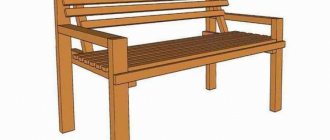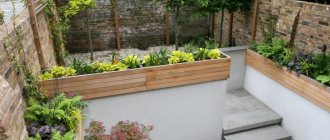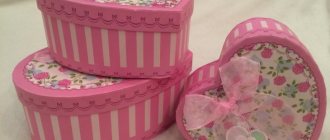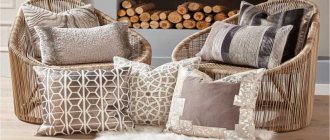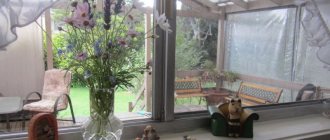Varieties of ornamental shrubs
The classification is based on the characteristic features of ornamental shrubs. Among them are light-loving properties, color, shape and density of the crown, appearance, and height. The last indicator is of particular importance when creating a hedge. In this case, bushes can have not only flowers, but also thorns.
Based on these factors, flowering, fruiting, low-growing and frost-resistant shrubs are distinguished. They are also classified according to the time of year. Gardeners who prefer spring varieties can plant forsythia, almond, spirea, serviceberry and kerria.
Jasmine, barberry, hydrangea and rose have a high level of decorativeness in summer. In autumn, the garden plot can be decorated with abelia, viburnum, rowan and hawthorn.
The winter garden will gain charm with rose hips, holly and yew. In areas with mild climates, plants such as Japanese maple, camellia, azalea, magnolia and witch hazel are quite popular.
Decorative garden plants
Planting ornamental shrubs can transform a former construction site or wasteland into a luxurious oasis in a few hours, if they were purchased in pots already grown. After purchase, they are replanted with a lump of earth.
In this case, all conditions regarding the characteristics of the soil and the degree of frost resistance should be taken into account. In view of this, you should choose those plants that will feel most comfortable on your site.
All trees and shrubs are divided into three types: beautifully flowering, evergreen and decorative deciduous garden plants.
Almost every person is familiar with such flowering ornamental shrubs as white acacia, perennial rose hips, and medicinal fragrant lilacs. Let's talk about other garden plants that have a more exotic appearance.
Ornamental shrubs for the Moscow region
In the Moscow region, winter lasts for 5 months. Only the most frost-resistant ornamental shrubs can survive such long-term exposure to low temperatures. It is desirable that they be unpretentious; we will write about them in the next section.
Additional conditions include adaptability to gas pollution and belonging to annuals. In summer, problems with growing usually do not arise. In areas with a temperate continental climate, the average air temperature is not lower than +21 °C.
Winter-hardy ornamental shrubs
This category includes shrubs and subshrubs that retain their decorative value throughout the year. They are characterized by resistance to strong winds and cold winters.
Lilac
It has a rich aroma, bright foliage and original color. There are many varieties. During the flowering period, they decorate the garden plot with lilac, white and pink tassels. Particularly popular is lilac, whose inflorescences are characterized by mixed shades.
Chubushnik
It is often called jasmine. Its advantages include bright white corollas, an alluring scent, abundant flowering, ease of care and endurance. The Snow Storm variety is often planted in gardens and park areas. Its main feature is terry corollas.
Clematis (clematis)
Decorative vines with flowers of various colors can be purple, pink, blue, lilac, crimson, burgundy and white. They decorate alpine slides and hedges. The diameter of the corollas is from 8 to 20 cm. Their shape also varies: terry, star-shaped and bell-shaped.
Spirea
As a result of abundant flowering, the plant is covered with pink and white corollas. Different varieties are often not similar to each other. Large and compact inflorescences become the main decoration of the spring garden. They can grow in both partial shade and sun.
Hydrangea
In the middle zone, only winter-hardy varieties can be grown. Beauties, whose homeland is the southern regions, are not able to survive in conditions of a sharply continental climate. Among the distinctive features are high decorativeness, impressive inflorescences, and luscious foliage. Spreading and spherical bushes are decorated with red, white, and blue corollas.
Heather
It is a shrub characterized by a large number of branches and triangular leaves. The latter can be gray, green, brown, orange and burgundy. Each inflorescence consists of goblet-shaped flowers of lilac, bluish-white, and soft pink shades. They delight from July to November.
Buddleya
Perennial with bright colors. Outwardly it resembles terry lilac. The length of the brushes often reaches 45 cm. The height of the bush is about 3 m. Thanks to the wide range of shades, the landscape with its help becomes much more impressive.
For what purposes are evergreen bushes grown?
Basically, bright hedges are made from beautiful evergreen shrubs. In addition, bushes can serve as a decoration element. Let's look at the main types of bushes that do not lose their green color even in winter.
Magnolia
A bush no more than 1 m high with beautiful green leaves. For a long time, the plant is able to maintain foliage, slightly changing only its color.
So, in the warm season the leaves are green in color, and in the cold season they acquire a copper tint.
Honeysuckle
Another green bush. It has a height of no more than 50 cm. It can grow in the shade, this will not affect its condition in any way. In winter, it is recommended to cover honeysuckle.
Rhododendrons
A low bush growing in a shady area. It is not recommended to water frequently. In winter, the plant also needs to be covered.
Evergreen shrubs for the garden
Among the most popular species that remain green in winter are:
- Aukubu is a beautiful poisonous shrub that reaches 2 m in height;
- Strawberry tree - after the appearance of pink and white corollas, fruits are formed that taste like wild berries;
- Boxwood - there are both tall and miniature varieties;
- Callistemon - long leaf blades, dark pink or lemon yellow inflorescences;
- Choisia - rounded crown shape, alluring aroma;
- Cistus - characterized by fleeting blooms and bright foliage.
Evergreen shrubs are recommended to be planted in spring. Thanks to them, the garden turns into a relaxation area. In large garden plots, plants from this category play the role of a connector between low-growing crops and trees.
Advantages of decorative landscaping
Working with green spaces, and especially with some types of plants, is not always easy and requires gardening skills from the master.
But, nevertheless, this type of decorative design has gained wide popularity due to a number of undeniable advantages:
- A wide variety of shapes and colors, natural colors and a pleasant appearance of the site.
- Improved environmental performance: air purification and circulation.
- Plants absorb any unpleasant odors and noise.
- Shading the recreation area and cooling the walls of residential buildings.
Green spaces have a lot of useful functions, and absolutely any home owner can work with them.
Variegated shrubs for the garden
Garden crops that are distinguished by atypical colors are considered variegated. They dilute monochromatic compositions, thereby increasing decorativeness.
Derain
An evergreen shrub characterized by white flowers and bright foliage. In autumn, blue drupes appear on it. The plant retains its decorative properties even in winter. Its shoots, painted in green, burgundy, yellow and bright red shades, make the garden more picturesque. Derain is unpretentious and frost-resistant.
Holly
Deciduous plant, decorated with berry-shaped fruits and axillary-type inflorescences. The shrub loves moisture and tolerates shade well. Doesn't adapt well when transplanted. To give the crown the required shape, pruning is carried out.
Weigela
Belongs to the Honeysuckle family. 10 varieties are grown for decorative purposes. They are deciduous shrubs that are easy to care for. Among the characteristic features are bell-shaped and funnel-shaped flowers, petiolate leaves, and an erect stem.
Hazel
The height of the bush is 7 m. The crown has an ovoid or spherical shape. The large leaves are serrated along the edges. After flowering, dark brown nuts are formed. They ripen towards the end of summer.
Skumpia
It is distinguished by fluffy inflorescences and brightly colored leaves. They can be burgundy, yellow, red, orange and even scarlet. The latter are especially noticeable in the autumn. Skumpia is classified as a member of the Sumakhov family. Both types are characterized by high decorativeness.
Bladderwort
This ornamental shrub will decorate any garden. Its spherical crown consists of spreading branches decorated with large leaf blades. Caring for the bladderwort does not take much time. It is unpretentious to soil and air. The shrub can be planted next to roads. His appearance will not suffer from this.
The most famous representatives
The names of most ornamental plants are already known to many:
- Violet. A plant with minimal care requirements, but with a wide variety of shapes and colors.
- Begonia. The indoor representative is no less original than its country counterpart. The rich color and richness of leaf shapes make it possible to create interesting flower compositions, for example, on a decorative ladder in the hallway.
- Orchid. Beautiful shade during the period of active flowering, stem and leaf resistant to temperature changes, unpretentious in care.
Today, several dozen original flower crops are known for decorating room interiors to suit every taste and preference of the apartment owner.
Exotic shrubs for the garden
Each garden plot can be made unique. To create an unusual landscape design, you need to plant exotic plants that match the preferences of the summer resident. Their list is quite extensive.
tree peony
It belongs to the same genus as herbaceous perennial, etc. Peony. The height of the bush is no more than 1.5 m. The flowers decorating the bushes are pink, burgundy and yellow. Corolla diameter 30 cm.
Rose
Double flowers vary in color. The number of shoots on one plant is from 3 to 5. The width of the bushes can reach 2 m. Among the distinctive features are a charming aroma, unpretentiousness, and resistance to adverse weather conditions.
Camellia
The flowers of this plant consist of dense petals. The spectrum contains all shades of red and cream. Mixed color camellias are similar to gardenias. The oval leaf blades have a leathery surface.
Hibiscus (Chinese rose)
The assortment of specialized stores includes annual and perennial varieties. The former are flowering plants, the latter are shrubs. During the flowering period, the bushes are covered with bright, large corollas.
Acacia
The plant, which attracts bees with its unusual aroma, belongs to the legume family. Height 30 m. Features include white inflorescences and thorns on the branches.
Rhododendron
Quite whimsical. Needs an acidic environment, moisture and fertilizers. Frost-resistant varieties and their hybrids are suitable for growing in the Moscow region.
Tips and tricks for decorating your garden with plants
When choosing plants, they adhere to a certain style. Baroque - an abundance of floral arrangements. Perennials in landscape design photos are well combined with annual seasonal flowers of bright colors. Climbing roses are used to decorate gazebos and arches.
A gazebo covered with flowers is a classic option for climbing roses.
The area, designed to resemble a natural landscape, includes alpine slides, various types of trees and shrubs, planted chaotically. The natural palette corresponds to the seasons: in spring there is a lot of greenery, summer is rich in flowers of various shapes and shades, in autumn ocher and yellow colors appear.
Stones, as a rule, are piled up in the form of a hill of arbitrary configuration.
In small areas, vertical flower beds are formed, flowerpots are used, and potted plants from the winter garden are displayed for the summer. Flowerbeds of strict geometry are a thing of the past. Replaced with curly, creative ones.
Important! Any style is complemented by attributes - small details that emphasize the individuality of the project and the taste of the designer.
Decorative flowers and plants are one of the main details of the interior of a house or garden landscape.
Fruit bushes for the garden that can be used as decorative
They can be seen in every garden plot. By planting them, the summer resident receives not only an interesting element of landscape design, but also tasty, healthy berries. This versatility is both a plus and a minus. This is due to more complex care. If agrotechnical requirements are not met, the harvest is unlikely to be abundant. Fruit bushes should be planted in autumn. The best time to plant is immediately after leaf fall.
Derain
A plant from the Dogwood family, characterized by winter hardiness and unpretentiousness. You can plant silky, blood-red and white turf on your garden plot. The height of the ornamental shrub does not exceed 3 m.
Thanks to its compact shape and abundant flowering, turf can decorate even a small garden. Ripe fruits do not have a pleasant taste.
Euonymus
It is classified as an evergreen plant. Characteristic features include oblong leaves, raceme-shaped inflorescences and fiery fruits. Even after leaf fall, it retains its decorative effect.
Quince
A shrub with powerful medicinal properties. The list of the most popular varieties includes such varieties as Yukigoten, Fascination, Nicoline, Pinklady, Zubutlinskaya. Needs fertile soil, sunlight and sufficient moisture.
cotoneaster
It is used to create hedges in the garden and in the park. After abundant flowering, many bright berries appear.
Barberry
Has a spreading crown. It is formed by long branches of a reddish hue. The height is 1.5 m. Corollas decorate it for quite a long period. The fruits are brightly colored and large in size.
Magnolia
An evergreen plant belonging to the Magnoliaceae family. It includes about 80 varieties. Flowers appearing in early spring are yellow, pink and white. Features also include a rich aroma, brown or ash-gray bark.
Rose hip
A beautiful unpretentious shrub. Wild rose is often planted as a thorny hedge. It is distinguished by arched branches, sharp sickle-shaped thorns, and greenish-red shoots.
Hawthorn
In appearance it is similar to the previous plant. Its decorative effect can be enhanced by pruning. Berries that ripen late in the season are often used for medicinal purposes.
Honeysuckle
A beautiful perennial that produces fruits with a specific taste. Jam and compotes are made from the berries. Arches are used to grow climbing varieties.
Elder
It has a rich aroma and medicinal properties. The height is about 10 m. With the help of proper pruning, the bush is given the required shape.
Kalina
It is distinguished by abundant flowering, a powerful healing effect and high decorative value. Belongs to the Honeysuckle family. The list of the most popular varieties includes such varieties as Bule de neige, Ural sweet, Altai. The last two varieties produce large fruits with good taste.
Which trees can be planted near the house, and which cannot, and why?
Trees add height to the garden. If the landscape is flat, it will be uninteresting to the eye. There should be few trees and they look better in small groups.
Why can’t you plant some trees near your house?
It is known that some trees take away negative energy, while others take away positive energy. You can’t plant trees close to your house, which take away positive energy. Such trees include, for example, birch.
Because of the root system
Powerful tall trees should not be planted on the site, and especially in the country. The root system can destroy the foundation of a building.
At what distance from the house and from each other can trees be planted?
Trees must be planted no closer than five meters from the wall of the building. As for the distance between the trees themselves, this depends on the size of their roof. The distance should be equal to the width of the roof of an adult tree
Why do fruit trees growing near houses bloom earlier in the spring than in other places?
Because the wall of the house protects the tree from cold and wind. This fact must be taken into account when choosing a place to plant a tree.
Decorative
Ornamental trees have unusual leaf shapes and beautiful fruits. Red rowan clusters look very decorative.
Maple is considered the tree with the most beautifully shaped carved leaves.
For other ornamental trees that can be planted in the garden plot, read the article “What ornamental trees should be planted on the plot and in front of the house?”
Conifers
Conifers perfectly decorate the site in winter. They release beneficial essential oils and purify the air. The aroma of pine has a beneficial effect on the nervous system. Conifers are auspicious trees.
Dwarf pine is ideally suited for a personal plot. Its small size and unusual shape of branches (in most cases located asymmetrically) create the feeling that you are in a fairy-tale forest.
In contrast to pine, silver spruce looks like a wonderful toy. It also resembles a fairytale setting.
Cypress grows well in most areas of the country. Although it also belongs to coniferous trees, it evokes completely different associations. Its pointed peak is akin to southern cypress trees and is reminiscent of a Mediterranean landscape.
short
Trees that grow no more than two meters in height are considered stunted. These are the trees that should be planted on a personal plot.
Trees 2 meters high can serve as vertical dominants and will give the garden the necessary height. It is necessary to take into account the maximum height of trees and not plant giants.
Beautiful
Not only conifers are famous for their beauty, but also deciduous trees. In summer, spring and autumn they delight the eye with their foliage, flowers and fruits, and in winter with beautiful structural compositions of bare trunks.
Red rowan looks great as soon as its fruits ripen. Bright red berries decorate the garden in autumn and winter. Against the background of white snow, red rowan fruits create a fantastic effect!
Decorative maple is one of the most amazing trees, the decorative effect of which seems artificial - it is so unusual. The combination of the beautiful shape of the maple leaf and its red color always attracts the eye.
What tree should I plant near my house to grow quickly?
Any tree grows for a long time. To grow it faster, you need to provide it with good care. Willow, poplar, and maple grow faster than other trees.
According to folk signs and superstitions
There is a popular belief that when a coniferous tree dies, its owner also dies. Many people remember the signs of our ancestors and are careful not to plant conifers on their plots.
To justify planting conifers on a site, we can say that conifers grow for a long time and usually do not die. To protect yourself, you can plant conifers away from your home.
For well-being and happiness in the family, you can plant cherries near your home. Cherry brings prosperity and wealth. If you place a barbecue under the cherry tree and light a fire in it during flowering, you will attract even more wealth with this action.
A tree can be planted in the garden in honor of the birth of a son. This is a very ancient sign. It symbolizes support for the growth of a child and the connection of people with nature. The tree is planted at the birth of a child, it grows with him.
Which tree should be planted at the birth of a son or daughter is a complex question. It could be oak or birch, spruce or pine. The main thing is that you should like the tree, you should plant it in a good mood, this tree should fit into the overall picture around the house.
But some skeptics do not advise planting a tree in honor of the birth of a child. What if it bothers someone and he wants to remove the planted tree? What then will happen to the person in whose honor it was planted? As an example, let's look at the story of Lyudmila K.
When I was born, my father planted a birch tree near the house in honor of my birth. I grew up and went to live in the city. After a while I began to get sick. When I came to visit my parents, I saw that my birch tree had begun to dry out due to a hole dug near its roots. Who dug it and why is unknown. My husband and I dug a hole and watered the birch tree. After some time, she recovered, and I stopped getting sick, too.
This story makes you think: is it worth planting a tree in honor of the birth of a child? Most likely there is no need to continue this tradition.
According to feng shui
Spruce absorbs all negative energy, accumulating it. Thus, it “cleanses” the area.
According to Feng Shui, rowan belongs to the element of fire and is responsible for popularity and reputation. It is better to plant it on the south side. By planting a rowan tree near your house, you will gain popularity and a good reputation. The neighbors will be friendly to you.
Maple carries wisdom. You can turn to this tree for advice.
In law
There is a law according to which the owner of the plot is obliged to plant trees no closer than three meters to the fence. This rule was introduced to ensure that your neighbor’s trees do not shade your area too much.
By adhering to this rule, you will eliminate disputes and unnecessary bickering with your neighbors.
According to Islam
Trees are highly revered in Islam. Allah placed trees on a par with the sun, moon, stars, mountains, as well as people and animals. In Islam, useful trees are associated with all the benefits that exist both in our world and in subsequent worlds. It is no coincidence that the first clothes of the inhabitants of paradise were tree leaves.
Prophet Muhammad calls us to sow. He says that the tree can be your key to Heaven.
Tree planting scheme
We have sorted out all the positive and negative aspects and now know which ornamental plants to plant near the house.
To distribute all the trees evenly throughout the area, I advise you to plant a group of the following trees in the far corner of the garden: dwarf pine, silver spruce and decorative maple. This composition will fill the background of the site well.
Closer to the house on the other side you can place a cypress tree.
What tree should I plant near my house?
Directly in front of the house, towards the gate, plant a rowan tree. Rowan is a low tree with a beautiful crown. Its red fruits look great in the background. The crown of the tree is also needed for shade near the house.
You may be interested in reading about the layout of the site in the article “Layout of a garden plot and vegetable garden”.
Mr. Summer Resident: basic tips for planting shrubs
Before planting, you need to choose a place to create a new composition. At this stage, you should focus on agrotechnical requirements. Seedlings of variegated varieties need plenty of sunlight.
Crops that are uniform in color are mostly shade-loving. Plants can be planted either individually or in a group. The ideal option is a composition of three ornamental shrubs.
Landing is carried out as follows:
- Prepare the soil (digging, removing stones and debris, applying fertilizers).
- Make holes for seedlings.
- Garden plants are planted.
The distance between the bushes depends on the size to which the bush grows. The remaining space can be filled with rhizomes and bulbous crops. If these recommendations are ignored, they will interfere with each other.
Shrubs are planted near fences and outbuildings. In flower beds they can be placed both in the center and in the back row. Each option is original in its own way. An exclusive ensemble of garden plants of different heights will become the “highlight” of your garden plot.
How to choose ornamental and fruit and berry bushes
The range of crops that are planted to decorate the garden is quite extensive. Among the determining factors are:
- personal preferences of the summer resident;
- garden plot area;
- estimated location of the bushes;
- difficulty of care;
- soil and climatic conditions;
- life span of the shrub (annual and perennial);
- compatibility with other garden crops to avoid dissonance between colors, aromas and shapes;
- decorative features.
Lush, spreading bushes are suitable for creating a landscape park. For those who have a small plot, these are unlikely to be suitable. In this case, they give preference to minimalist compositions, choosing varieties that can take any form. Their distinctive feature is the absence of problems with cutting.
